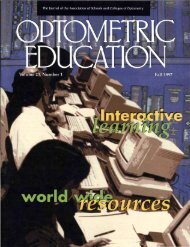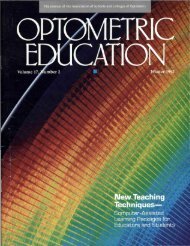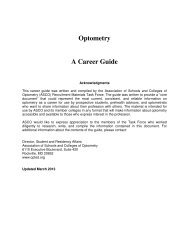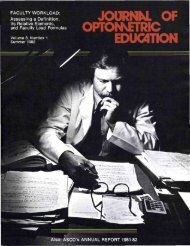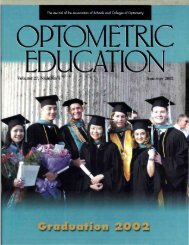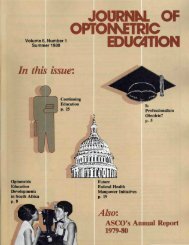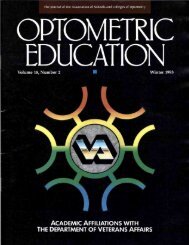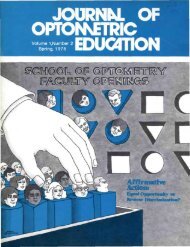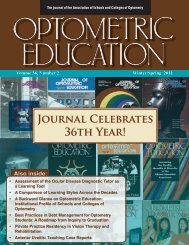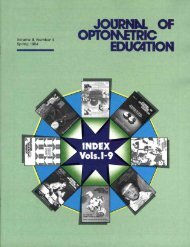Spring 1992, Volume 17, Number 3 - Association of Schools and ...
Spring 1992, Volume 17, Number 3 - Association of Schools and ...
Spring 1992, Volume 17, Number 3 - Association of Schools and ...
You also want an ePaper? Increase the reach of your titles
YUMPU automatically turns print PDFs into web optimized ePapers that Google loves.
Abstract<br />
Optometric educators have a<br />
responsibility not only to serve<br />
students undertaking studies in<br />
optometry, but also to save <strong>and</strong> educate<br />
the 'wider community. At the<br />
University <strong>of</strong> Neiv South Wales,<br />
Australia, a Vision Education Centre<br />
(\''bC) has been founded which is<br />
<strong>of</strong> mutual benefit to optometry <strong>and</strong><br />
to the local community. The centre<br />
is an innovative <strong>and</strong> unique multi-<br />
Iroel learning <strong>and</strong> teaching centre,<br />
which not only addresses the needs<br />
<strong>of</strong> optometry students to gain clinical<br />
<strong>and</strong> communication skills but also<br />
provides vision care ami education<br />
in visual science to local schools. It<br />
is a centre where young patients can<br />
come in large groups, <strong>and</strong> actively<br />
learn about visual science during an<br />
attendance at the clinic for a routine<br />
eye examination.<br />
The Vision Education Centre has<br />
been highly successful <strong>and</strong> provides<br />
direct benefits to optometry students,<br />
school children <strong>and</strong> their parents, the<br />
School <strong>of</strong> Optometry Clinic, primary<br />
school teachers, <strong>and</strong> researchers in<br />
the area <strong>of</strong> children's vision. Indirectly,<br />
the centre is also a means <strong>of</strong><br />
increasing public awareness <strong>of</strong> both<br />
the University <strong>and</strong> the pr<strong>of</strong>ession <strong>of</strong><br />
optometry. The increased pediatric<br />
experience has served to heighten an<br />
awareness <strong>of</strong> the visual needs <strong>of</strong> the<br />
young patient, <strong>and</strong> the obligations <strong>of</strong><br />
optometiy to younger members <strong>of</strong> the<br />
communilv.<br />
Introduction<br />
The Vision Education Centre (VEC)<br />
at the University <strong>of</strong> New South Wales,<br />
Sydney, was conceived as a means<br />
by which final year students could<br />
see more pediatric patients. Basically,<br />
the Centre is a means <strong>of</strong> attracting<br />
young patients to our clinic by providing<br />
the patients with an exciting<br />
<strong>and</strong> meaningful learning experience.<br />
Dr. Junghans is a lecturer at the School <strong>of</strong> Optometry,<br />
University <strong>of</strong> New South Wales, Sydney, Australia,<br />
<strong>and</strong> coordinator <strong>of</strong> the Vision Education Center.<br />
Dr. Crewther is a senior research fellow at the School<br />
<strong>of</strong> Optometry, University <strong>of</strong> New South Wales, Sydney,<br />
Australia, <strong>and</strong> designer <strong>of</strong> the Vision Education<br />
Centre.<br />
The University <strong>of</strong> New South Wales School <strong>of</strong> Optometry<br />
became an ASCO affiliate member in January<br />
<strong>1992</strong>.<br />
Despite its simplicity, the potential<br />
use <strong>of</strong> the VEC as a tool to satisfy<br />
a number <strong>of</strong> teaching, research <strong>and</strong><br />
community-service goals in a timeefficient<br />
manner readily became<br />
apparent. This is particularly pertinent<br />
at a time when resources <strong>and</strong><br />
funding are being cut back in real<br />
terms, <strong>and</strong> it is necessary to take a<br />
fresh look at curricula, <strong>and</strong> to implement<br />
alternate teaching methodologies<br />
that more successfully stimulate<br />
the learning process. 1 Such a call for<br />
restructuring <strong>of</strong> academic programs<br />
to ensure balance between the various<br />
facets <strong>of</strong> clinical <strong>and</strong> science disciplines<br />
<strong>and</strong> to improve the quality<br />
<strong>of</strong> teaching within optometry has<br />
recently been made. 2 ' 3<br />
The plan for the VEC is based upon<br />
interactive learning programs between<br />
primary <strong>and</strong> tertiary students,<br />
interaction across the disciplines <strong>of</strong><br />
education <strong>and</strong> optometry, <strong>and</strong> extension<br />
to research opportunities. As<br />
such, it provides an excellent model<br />
<strong>of</strong> a multi-functional facility. It also<br />
provides an example <strong>of</strong> an alternate<br />
teaching strategy with multiple goals.<br />
The success <strong>of</strong> the VEC has been<br />
far greater than anticipated. The local<br />
school teachers are grateful, the<br />
families <strong>of</strong> those children identified<br />
to have visual problems are very<br />
thankful, <strong>and</strong> a new enthusiasm for<br />
pediatric optometry has spread<br />
through the school. In addition, the<br />
children bring a breath <strong>of</strong> fresh air<br />
into our school every time a class<br />
visits, which has had a most positive<br />
effect on all our staff. This paper<br />
describes the centre as it has run since<br />
mid-1990.<br />
How the VEC Operates<br />
The Vision Education Centre invites<br />
classes from nearby infants <strong>and</strong><br />
primary schools to visit the School<br />
<strong>of</strong> Optometry as an excursion. Each<br />
class is divided into two groups.<br />
While one half has a comprehensive<br />
eye <strong>and</strong> vision screening by fourthyear<br />
students, the other half receives<br />
a short talk followed by interactive<br />
activities based on optics, physiological<br />
optics, ocular anatomy <strong>and</strong> eye<br />
examination techniques. After one<br />
hour, the children have refreshments<br />
<strong>and</strong> the groups interchange. An<br />
activity book with diagrams, word<br />
games <strong>and</strong> home-based projects is<br />
given out at the end <strong>of</strong> the day to<br />
reinforce terms <strong>and</strong> concepts covered<br />
during the visit. To encourage periodic<br />
visits to the centre, three educational<br />
packages have been prepared<br />
with information appropriate<br />
for infants (ages 5-8), lower primary<br />
(ages 8-10) <strong>and</strong> upper primary (ages<br />
10-12). Thus, it is intended that<br />
children will come to the centre every<br />
three years.<br />
Parents <strong>and</strong> teachers are given<br />
questionnaires before the visit so that<br />
children with particular visual or<br />
educational concerns can be identified.<br />
A set <strong>of</strong> lesson plans is sent to<br />
each teacher beforeh<strong>and</strong>, to allow the<br />
class to prepare for the day. After the<br />
eye exam, parents are sent a report<br />
<strong>of</strong> the findings, <strong>and</strong> teachers are<br />
alerted <strong>of</strong> the children who require<br />
further attention. Parents <strong>of</strong> any<br />
children found requiring further<br />
investigation have the choice <strong>of</strong><br />
consulting their local practitioner, or<br />
the clinic at the School <strong>of</strong> Optometry<br />
for a more detailed investigation.<br />
As our graduates move<br />
out into the optometric<br />
community, it is hoped<br />
that they will take with<br />
them extra confidence<br />
to meet the dem<strong>and</strong>s <strong>of</strong><br />
young patients.<br />
The children are met outside the<br />
building at the bus <strong>and</strong> welcomed.<br />
At the reception area they are given<br />
prepared sticky name tags which are<br />
<strong>of</strong> two colors to indicate the two<br />
groupings for the day (it is best to<br />
put a little more than half the boys<br />
in the first science talk). The children,<br />
in walking to the consulting rooms<br />
<strong>and</strong> the classroom area, are given a<br />
description <strong>of</strong> the rooms they pass<br />
— head <strong>of</strong> school, research labs,<br />
administration <strong>of</strong>fices, etc. In this way<br />
they are introduced to the range <strong>of</strong><br />
activities <strong>of</strong> a university, <strong>and</strong> the similarities<br />
between their own school <strong>and</strong><br />
the "schbol <strong>of</strong> optometry." It is important<br />
with the younger .children, to<br />
include t\ group visit in a consulting<br />
room before any <strong>of</strong> the individual eye<br />
examinations commence, as some<br />
children find the similarity between<br />
the dentist's <strong>and</strong> the optometrist's<br />
<strong>Volume</strong> <strong>17</strong>, <strong>Number</strong> 3 / <strong>Spring</strong> <strong>1992</strong> 83



